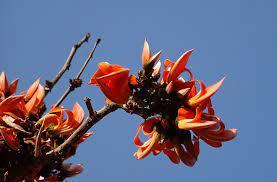White Palash Plant
White Palash (Butea monosperma 'Shweta'), a rare deciduous tree, grows 10-15 m with slow growth in well-drained sandy-loam soil, thrives in full sun with low moisture, is non-edible with medicinal benefits, and produces 2.5 cm white flowers in Feb-Apr.

Habit
Deciduous Tree
Height
10-15 m
Growth
Slow
Soil
Well-drained, sandy-loam
Shade
Full Sun
Moisture
Low; drought-tolerant
Edible
No
Medicinal
Anti-inflammatory, antimicrobial
Origin
South Asia
Climatic Condition
Tropical/Subtropical
Temperature (°)
20-40
Humidity (%)
40-60
Potting media
50% sand, 30% loam, 20% compost
Fertilizers
Balanced NPK (10-10-10)
Watering
Water sparingly, once every 10-14 days when established
Plant Weight
~50-100 kg
Flowering Time
Feb-Apr
Soil Ph level
6.0-7.5
Water Ph level
6.5-7.5
Soil EC
0.5-1.5
Yield Per Plant
Gum: 1-2 kg
NPK ratio
10:10:10
life Span
50-80 years
Health Benefits
Supports digestion, skin health
uggested Grow Media or Potting Mix ?
40% sand, 40% loam, 20% perlite
Suggested Fertigation/Fertilizers
Apply balanced fertilizer every 3 months
Common Diseases and Remedies
Leaf Spot, Powdery Mildew, Aphids, Root Rot, Spider Mites
Brown/black spots on leaves, White powdery patches on leaves, Curling, yellowing leaves, Yellowing, wilting of plants, Yellowing, stippling on leaves
Copper-based fungicides, Fungicides containing sulfur ,Imidacloprid-based insecticides, Fungicides containing metalaxyl, Acaricides

